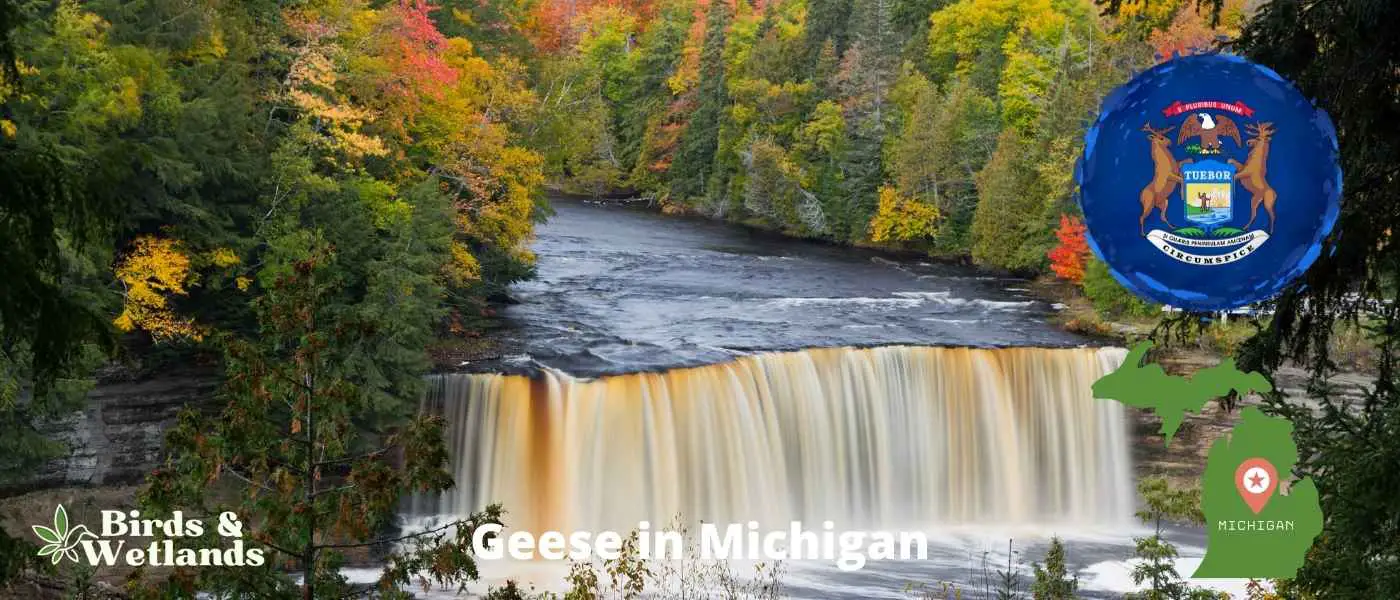Birds are fascinating creatures and they can be found in many different places. If you’re a bird watcher, Michigan is definitely a place you want to check out. There are geese to be seen everywhere! In parks, on golf courses, by the water – you name it, there’s a good chance you’ll find geese there.
What Geese Are in Michigan?
Michigan is home to five species of goose and three species of swan.
- Canada Goose
- Snow Goose
- Cackling Goose
- Brant
- Greater White-Fronted Goose
Swans in Michigan include Tundra Swan, Trumpeter Swan and Mute Swan.
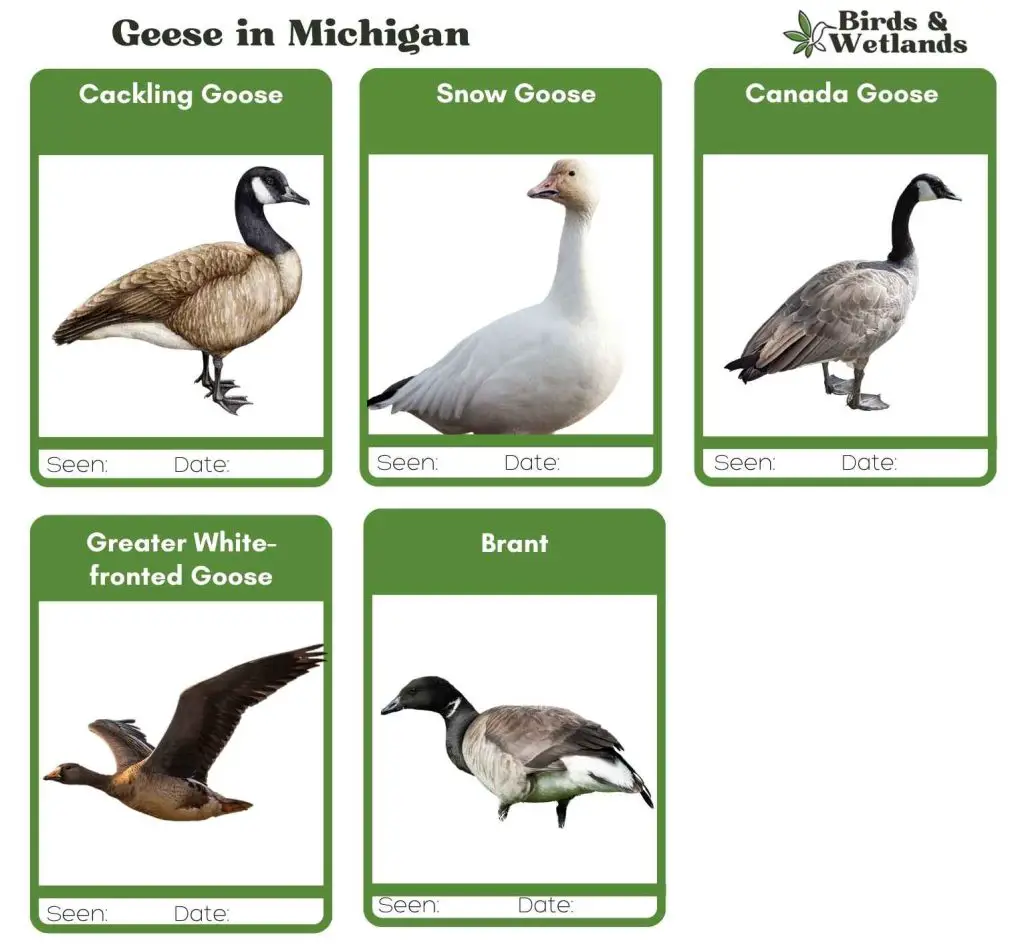
Canada Goose
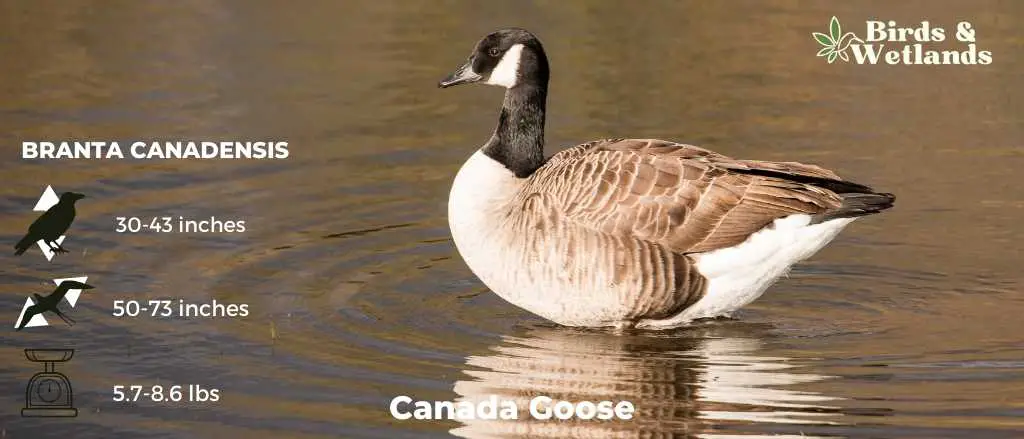
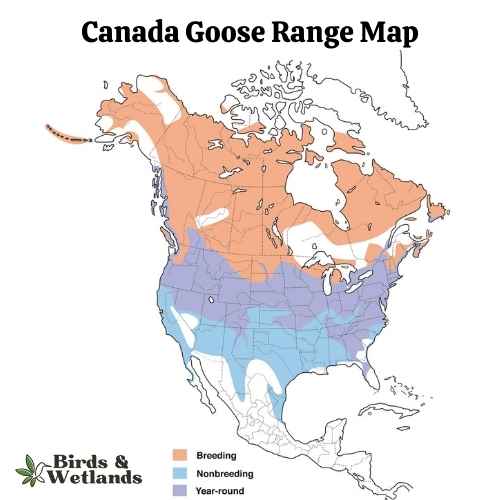
Canada Goose Sound
Scientific Name: Branta canadensis
Length: 30 to 43 in
Wingspan: 50–73 in
Weight: 5.7–14.3 lb
The Canada Goose is a large, well-known species of waterfowl noted for its distinctive appearance, familiar “honk,” and migratory behavior.
Appearance: Both male and female Canada Geese have a similar appearance, featuring a black head and neck with distinctive white patches on the cheeks and chin. The body is primarily brown with a lighter, often white, underbelly.
Diet: Canada Geese primarily feed on plant matter, including grasses, aquatic vegetation, and grains. They can often be seen grazing in parks, lawns, and fields, as well as dabbling in water bodies.
Reproduction: Canada Geese typically nest on the ground near water bodies, often on islands or other isolated areas to avoid predators. The female lays a clutch of about 4 to 6 eggs, which she incubates alone for around a month.
Snow Goose
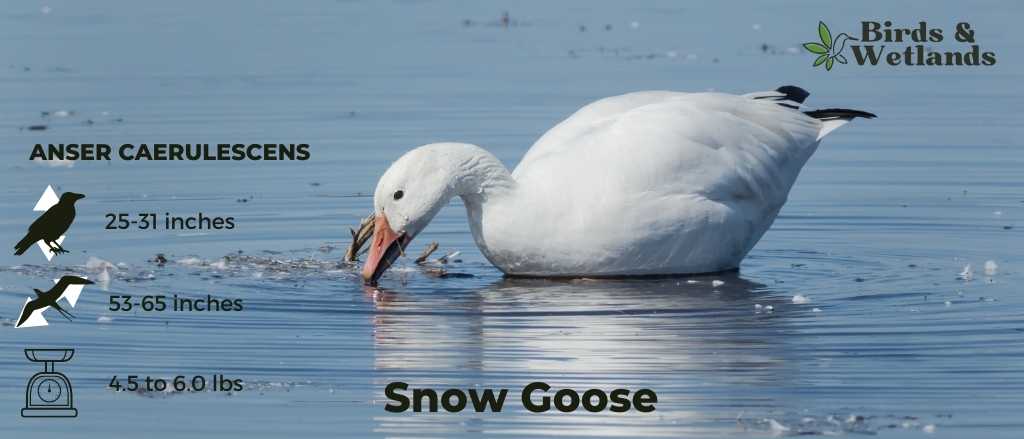
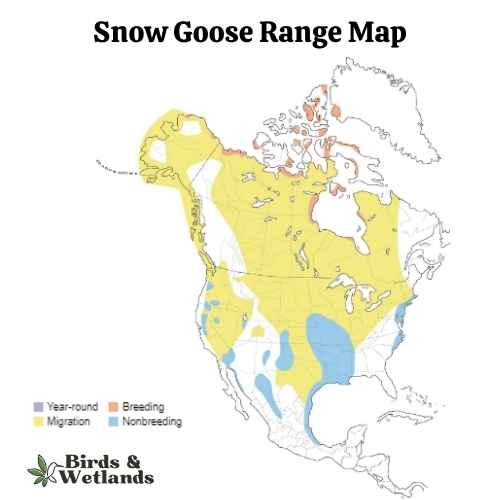
Snow Goose Sound
Scientific Name: Anser caerulescens
Length: 25 to 31 in
Wingspan: 53 to 65 in
Weight: 4.5 to 6.0
The Snow Goose is a large species of waterfowl known for its vibrant white plumage and significant migratory flights.
Appearance: True to their name, Snow Geese are predominantly white with black wingtips. They also have a pink bill, pink legs and feet. A color morph, known as the “Blue Goose,” displays a bluish-gray body with a white head, but is considered the same species.
Diet: Snow Geese primarily feed on plant matter, such as grasses, sedges, and small grains. They can often be seen in large flocks foraging in fields and marshes, and during migration and winter, they can cause considerable damage to agricultural fields due to their feeding habits.
Reproduction: Snow Geese typically nest on the tundra, near water bodies. The female builds the nest and lays a clutch of about 3 to 5 eggs, which she incubates alone for approximately three weeks. Once hatched, the goslings can feed themselves but stay with their parents for protection until they can fly.
Cackling Goose
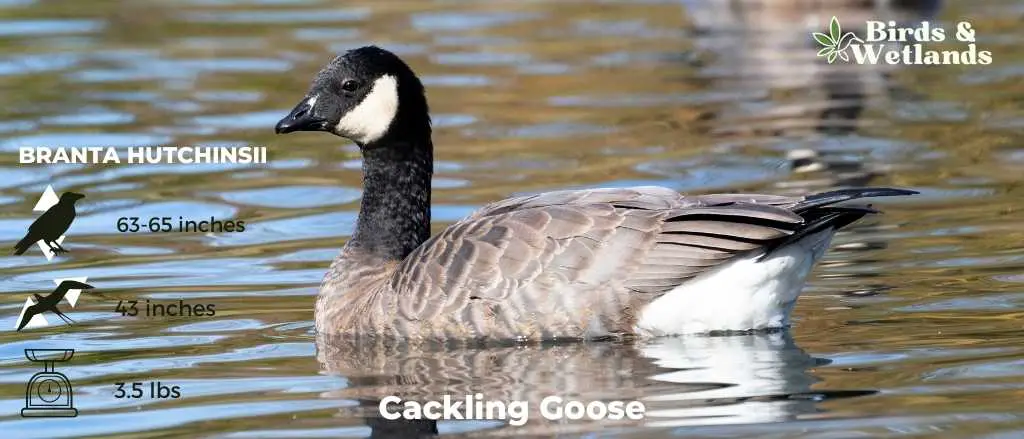
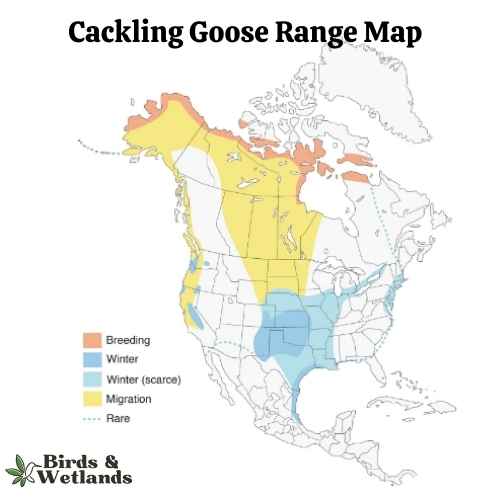
Listen
Scientific Name: Branta hutchinsii
Length: 24.8–25.6 in
Wingspan: 43-45.7 in
Weight:3.5 lbs
Cackling Geese are particularly known for their high-pitched, cackling calls, which is the source of their name. Despite their small size, these geese are renowned long-distance migrants, with some populations traveling thousands of miles between breeding and wintering grounds.
Appearance: With a similar color pattern to the larger Canada Goose, the Cackling Goose features a black head and neck, white chinstrap, light tan to cream chest, and brownish-grey body. One defining characteristic is its noticeably smaller size and stubbier neck compared to its larger counterparts.
Diet: Like many geese, the Cackling Goose’s diet mainly consists of plant matter. This includes grasses, seeds, and aquatic vegetation. They are often seen grazing on land or dabbling in shallow water.
Reproduction: Cackling Geese usually nest on the ground in elevated areas near water bodies, such as riverbanks or lakeshores. The female lays a clutch of 2 to 8 eggs and is responsible for incubation, while the male stands guard nearby. Incubation lasts for about a month.
Brant
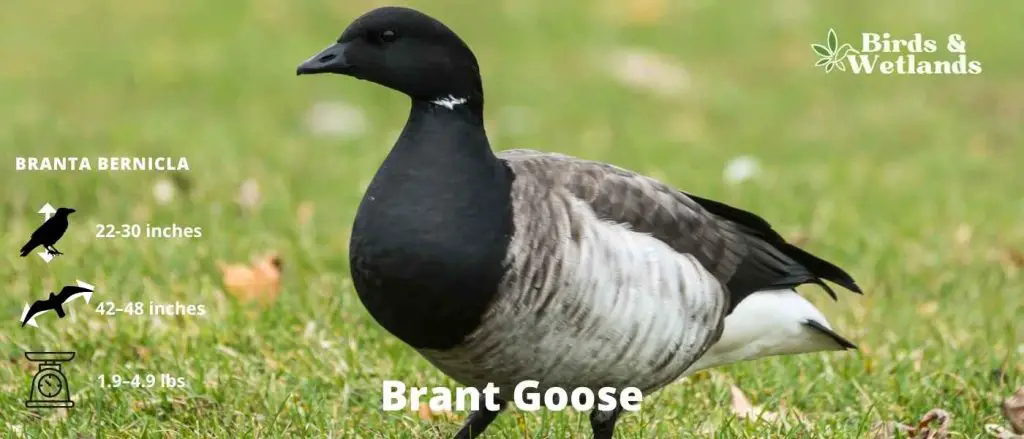
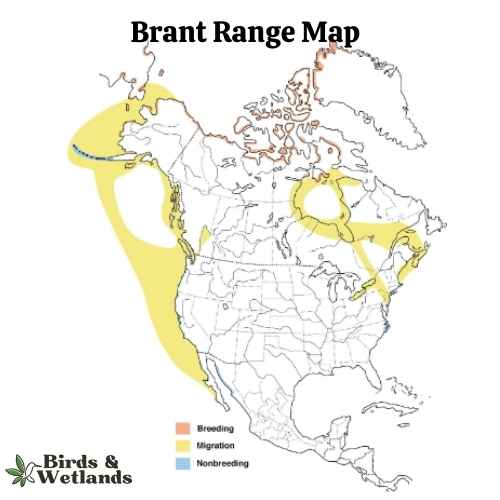
Listen
Scientific Name: Branta bernicla
Length: 22–26 in
Wingspan: 42–48 in
Weight: 1.9–4.9 lb
The Brant is a compact species of goose that is known for its striking appearance and interesting migratory patterns.
Appearance: The Brant is recognized for its dark, sooty color with a white crescent on the neck. The body is mostly black to dark gray, contrasting with the lighter underparts. Its small size, as compared to other geese, and short, stubby bill are other distinct features.
Diet: The Brant’s diet primarily consists of aquatic plants, especially eelgrass and sea lettuce. During the breeding season, they may also feed on grasses, sedges, and insects.
Reproduction: Brants typically breed in the high Arctic tundra. The female lays a clutch of 3 to 5 eggs in a ground nest, which she incubates for about a month.
Notably, Brants make an impressive long-distance migration every year. They spend their winters along both the east and west coasts of the United States and travel to the Arctic regions of Canada, Alaska, and even Russia to breed.
Greater White-fronted Goose
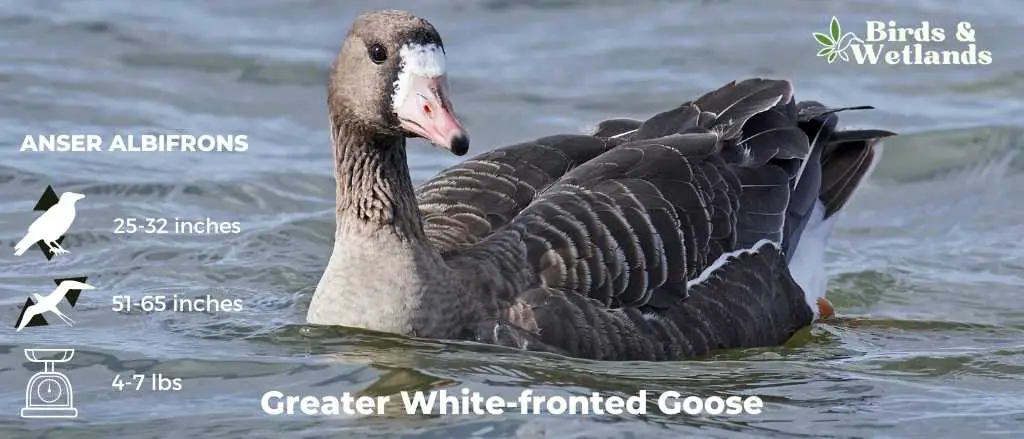
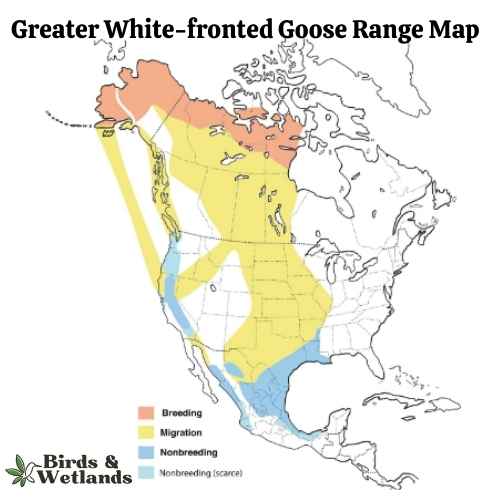
Listen
Scientific Name: Anser albifrons
Length: 25 to 31 in
Wingspan: 53 to 66 in
Weight: 3.3 to 6.6
The Greater White-fronted Goose is a medium to large waterfowl species, widely distributed across the Northern Hemisphere, particularly in North America.
Appearance: As the name suggests, these geese display a prominent white patch at the base of their bill. Their bodies are gray-brown, and their breasts are often marked with dark blotches. They possess a pinkish bill and orange legs and feet.
Diet: The Greater White-fronted Goose is a herbivore and feeds mainly on plant material. Its diet consists of grasses, sedges, grains, and berries. When wintering, these geese can often be found in agricultural fields, feasting on leftover grains and crops.
Reproduction: This species nests on the ground, often in areas with good visibility such as slopes or ridges. The female lays a clutch of 4 to 5 eggs, which she incubates for nearly a month. Once hatched, the young ones are taken care of by both parents until they are able to fly.
Are There Any Resident Flocks of Geese in Michigan?
Michigan is home to a large population of Canada geese, with birds nesting in every county across the state. However, these iconic birds are most commonly found in the southern third of Michigan, where they make up around 80% of the total goose population.
In recent years, many Canada geese frequently visit yards and lush lawns. Some Canada geese have built nest sites near lakes and golf course ponds.
This situation has prompted the Michigan Department of Natural Resources to release guidelines on how to prevent conflicts with these federally protected migratory birds such as not intentionally feeding Canada geese and use of non-lethal ways to deal with these geese such as the use of bird bangers, bird scare balloons, mylar scare tape, plastic flags and electronic noise systems.
Hunting Geese in Michigan
In Michigan, you need a license to hunt geese. In addition to a base license, all waterfowl hunters are required to purchase a Michigan waterfowl hunting license and a Federal Migratory Bird Hunting Stamp.
The Harvest Information Program (HIP) endorsement is required for all those hunting migratory birds.
Can You Shoot a Goose in Michigan?
When hunting geese in Michigan, you are allowed to use a bow and arrow, a crossbow or a shotgun 10-gauge or smaller.
Shotguns capable of holding more than three shells must be plugged with a one-piece filler incapable of removal without disassembling the gun so that the total capacity of the shotgun does not exceed three shells.
This equipment will help you be successful in your hunt while obeying the law.
Additionally, you need to be familiar with Michigan’s daily bag and possession limits. For example, Dark goose (Canada, brant and white-fronted) has a daily bag of 5 and possession limits of 15 in all hunting zones (North, Middle and South zones).
Where Can I Hunt Geese in Michigan?
Whether you’re a seasoned hunter or a first-time goose chaser, the Fennville Farm Unit of the Allegan State Game Area is a great place to hunt geese in Michigan.
The farm unit covers nearly 5,000 acres of open fields and woodlands, providing plenty of space for hunters to spread out.
Is There a Goose Hunting Season in Michigan?
For those looking to bag a goose or two in Michigan, it’s important to know when hunting season is. The state has a long season that stretches from September 1 all the way into early February. That means there’s plenty of time to get out and hunt.
Conclusion on Geese in Michigan
If you’re looking to see some of Michigan’s beautiful waterfowl, head out to one of the many state parks that are home to these birds.
With a little luck, you’ll be able to spot geese, swans, and other aquatic creatures swimming on the surface or nesting in the nearby pond.

